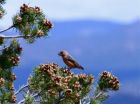(Press-News.org) HOUSTON - Researchers have identified a pivotal protein in a cellular transformation that makes a cancer cell more resistant to treatment and more capable of growing and spreading, making it an inviting new target for drug development.
Additionally, the international team led by scientists at The University of Texas MD Anderson Cancer Center found the cancer drug sunitinib potentially has a new role in treating triple-negative, claudin-low breast cancer, a particularly resistant version of a type of cancer that is already difficult to treat.
"We found that FOXC2 lies at the crossroads of the cellular properties of cancer stem cells and cells that have undergone epithelial to mesenchymal transition (EMT), a process of cellular change associated with generating cancer stem cells," said senior author Sendurai Mani, Ph.D., assistant professor in MD Anderson's Department of Translational Molecular Pathology and co-director of the Metastasis Research Center.
Cancer stem cells are fewer in number than other tumor cells, yet research has tied them to cancer progression and resistance to treatment. Abnormal activation of the epithelial to mesenchymal transition can create cancer stem cells, Mani noted.
Sunitinib stifles growth of cancer stem cells
"There are multiple molecular pathways that activate EMT," Mani said. "We found many of these pathways also activate FOXC2 expression to launch this transition, making FOXC2 a potentially efficient check point to block EMT from occurring," Mani said.
Research uncovering this connection, published in the journal Cancer Research, focused on cell line and mouse model experiments. The next important step will be to assess the expression and activity of FOXC2 in human tumor samples, Mani said.
In the meantime, sunitinib, known commercially as Sutent and approved by the U.S. Food and Drug Administration for three other cancers, provides interesting, more immediate, potential.
"FOXC2 is a transcription factor, a protein that binds to DNA in the promoter region of genes to activate them. For a variety of reasons, transcription factors are hard to target with drugs," Mani said.
The team found that FOXC2 also regulates the platelet derived growth factor receptor (PDGFR-Beta). In cancer cell lines, they found that the PDGFR-Beta inhibitor sunitinib inhibited growth of cells with EMT or cancer stem cell properties that have active FOXC2.
Mice with triple-negative breast cancer treated with sunitinib had smaller primary tumors, longer survival, and fewer incidences of metastasis. There also was a steep drop in the cells' ability to form mammospheres, a hallmark of cancer stem cells.
EMT: an embryonic development process reactivated by cancer
Mani is an expert on EMT and cancer stem cells and was the first author on the original EMT study in Cell when he was with Robert Weinberg, Ph.D., at the Whitehead Institute/Massachusetts Institute of Technology.
Epithelial to mesenchymal transition is important to embryonic development, turning stationary epithelial cells into mobile mesenchymal cells to move them within the embryo. For example, a cell might be converted and then gather with other cells forming, for example, the kidney. Once there, it transitions back to an epithelial cell again and stays put.
Research has shown that carcinomas, tumors that form in the epithelium (lining) of organs are able to reactivate EMT. About 85 percent of all solid tumors are carcinomas.
The researchers focused on a recently discovered subtype of triple-negative breast cancer, so called because these cells lack receptors for three common treatments for breast cancer and thus are hard to treat. The claudin-low/basal B subtype is deficient in claudin, a membrane protein that binds epithelial cells together, and is particularly aggressive.
Building on an earlier paper that showed FOXC2 is expressed more heavily in cells after EMT is induced by a variety of factors, Mani and colleagues followed up first by using short hairpin RNA to suppress FOXC2 in breast cancer cells.
Blocking FOXC2 had no effect on cell growth, but it altered both the physical appearance of the cells, increased their ability to cluster like epithelial cells, reduced protein biomarkers of mesenchymal cells and increased levels of E-cadherin, an important epithelial cell marker.
Additional experiments showed that FOXC2 did not regulate three proteins known to separately launch EMT. They also found that breast cancer cells primed to undergo EMT became less invasive when FOXC2 was knocked down.
Impact on cancer stem cells
Knocking down FOXC2 in mammary epithelial cell lines with stem cell properties caused:
A reversal of expression of two cell surface cancer stem cell markers, CD44 and CD24.
A reduction in their ability to form mammospheres.
Heightened sensitivity to the chemotherapy drug paclitaxel. Chemo resistance is a hallmark of cancer stem cells.
They also found FOXC2 elevated in cancer cells with stem cell properties.
Examining cell lines in malignant human mammary epithelial cells showed:
Forced expression of FOXC2 alone is sufficient to induce EMT resulting in cancer stem cells.
Overexpression of the FOXC2 protein led to more efficient tumor formation.
Aggressive growth and metastasis in mice, with FOXC2-enhanced cells spreading to the lungs, liver, hind leg bone and to the brain, while unenhanced cancer cells did not spread at all.
FOXC2 boosts claudin-low breast cancer cells
FOXC2 was found overexpressed in metastatic tumors compared to primary tumors in two claudin-low human breast cancer xenografts. A second experiment showed all six claudin-low cell lines overexpressed FOXC2 compared to none of the other 7 cell lines. FOXC2 is required both for mesenchymal and invasive capacity of three claudin-low breast cancer cell lines. Blocking FOXC2 increased the cells' epithelial properties and decreased mesenchymal characteristics.
Mani and colleagues had earlier found increased expression of PDGFR-B in cells forced to undergo EMT. "We thought PDGFR-B might be a druggable target in these FOXC2-expressing cells," Mani said. They found suppressing FOXC2 reduced the ability of three cancer cell lines to migrate towards PDGF-B.
Mani said the team believes that targeting FOXC2 pathway using either PDGFR-beta inhibitors or other yet-to-be-known small-molecule inhibitors will be an effective therapeutic strategy for inhibiting EMT and consequently reducing EMT/cancer stem cell-associated metastasis, relapse and therapy resistance.
MD Anderson has filed a patent application connected to this study.
INFORMATION:
Co-authors with Mani are co-first authors Brett Hollier, Ph.D., Agata Tinnirello, Ph.D., and Steven Werden, Ph.D., Kurt Evans, Joseph Taube, Ph.D., Tapasree Roy Sarkar, Ph.D., Nathalie Sphyris, Ph.D., Maryam Shariati and Sreedevi Kumar, all of MD Anderson's Department of Translational Molecular Pathology; Venkata Battula, Ph.D., of MD Anderson's Department of Leukemia; Jason Herschkowitz, Ph.D., and Jeffrey Rosen, Ph.D., of Baylor College of Medicine; Rudy Guerra, Ph.D.,of Rice University; Jeffrey Chang, Ph.D., of the University of Texas Medical School at Houston; Naoyuki Miura, M.D., Ph.D., of Hamamatsu University School of Medicine, Japan.
This research was funded by grants from the National Cancer Institute of the National Institutes of Health (CA155243-01 and R00LM009837) and MD Anderson's NCI cancer center support grant (CA16672), the Cancer Prevention and Research Institute of Texas (CPRIT), and a Susan G. Komen Postdoctoral Fellowship.
Protein central to cancer stem cell formation provides new potential target
FOXC2 is vital to epithelial-mesenchymal transition in breast cancer; FDA-approved drug blocks its effect in preclinical studies
2013-02-13
ELSE PRESS RELEASES FROM THIS DATE:
NASA's Chandra suggests rare explosion created our galaxy's youngest black hole
2013-02-13
New data from NASA's Chandra X-ray Observatory suggest a highly distorted supernova remnant may contain the most recent black hole formed in the Milky Way galaxy. The remnant appears to be the product of a rare explosion in which matter is ejected at high speeds along the poles of a rotating star.
The remnant, called W49B, is about a thousand years old as seen from Earth and located about 26,000 light-years away.
"W49B is the first of its kind to be discovered in the galaxy," said Laura Lopez, who led the study at the Massachusetts Institute of Technology. "It appears ...
By guessing, clinicians may miss 3/4 of alcohol problems
2013-02-13
SAN ANTONIO, Texas (Feb. 13, 2013) — By relying on hunches rather than posing a few screening questions, primary care clinicians may be missing three-fourths of the alcohol problems in their patients, a newly released analysis shows.
"It's often off the radar — people come in for hypertension and are not asked how much they drink," said study co-author Barbara J. Turner, M.D., M.S.Ed., M.A., M.A.C.P., of UT Medicine San Antonio. Primary care offices typically don't have good systems to administer questionnaires to screen for certain problems, including alcohol consumption, ...
Tube versus IV feeding in malnourished pediatric cancer patients
2013-02-13
About 60 percent of pediatric cancer patients experience malnourishment during treatment. At that point, patients and families have a choice: tube feeding or IV nutrition supplement. Which would you choose? A study published this week in the Journal of Pediatric Oncology Nursing shows that families' perceptions, especially of the discomfort of tube feeding, leads to choosing IV over tube – despite the fact that tube feeding is usually the better choice, associated with better gut function and lower rates of infection.
"Despite the benefits of tube feeding, we found a ...
Key molecule suppresses growth of cancerous liver tumors, Mayo study finds
2013-02-13
ROCHESTER, Minn. -- A molecule already implicated in a number of diverse cellular functions can suppress the growth of tumors in the liver, a Mayo Clinic Cancer Center study has found. Its name is IQGAP1, and when the molecule is active in the cells that surround a tumor cell, this "tumor microenvironment" becomes less hospitable to cancer growth. When the molecule is deficient, cancer thrives.
Results of the study appear in the Journal of Clinical Investigation. The findings give new insight into cancer metastasis, the ability of a tumor to spread from its primary site ...
Engineers show feasibility of superfast materials
2013-02-13
SALT LAKE CITY, Feb. 13, 2013 – University of Utah engineers demonstrated it is feasible to build the first organic materials that conduct electricity on their edges, but act as an insulator inside. These materials, called organic topological insulators, could shuttle information at the speed of light in quantum computers and other high-speed electronic devices.
The study published this week in the journal Nature Communications will help pioneer a new field of research in materials science, in the same way organic materials lowered the cost and eased production of light-emitting ...
Epigenetics shapes fate of brain vs. brawn castes in carpenter ants
2013-02-13
PHILADELPHIA — The recently published genome sequences of seven well-studied ant species are opening up new vistas for biology and medicine. A detailed look at molecular mechanisms that underlie the complex behavioral differences in two worker castes in the Florida carpenter ant, Camponotus floridanus, has revealed a link to epigenetics. This is the study of how the expression or suppression of particular genes by chemical modifications affects an organism's physical characteristics, development, and behavior. Epigenetic processes not only play a significant role in many ...
Discovering cell surface proteins' behavior
2013-02-13
Contact:
Bingyun Sun, 778.782.9097, bingyun_sun@sfu.ca
Carol Thorbes, PAMR, 778.782.3035, cthorbes@sfu.ca
Simon Fraser University is Canada's top-ranked comprehensive university and one of the top 50 universities in the world under 50 years old. With campuses in Vancouver, Burnaby and Surrey, B.C., SFU engages actively with the community in its research and teaching, delivers almost 150 programs to more than 30,000 students, and has more than 120,000 alumni in 130 countries.
Simon Fraser University: Engaging Students. Engaging Research. Engaging Communities.
...
Southwest regional warming likely cause of pinyon pine cone decline, says CU study
2013-02-13
Creeping climate change in the Southwest appears to be having a negative effect on pinyon pine reproduction, a finding with implications for wildlife species sharing the same woodland ecosystems, says a University of Colorado Boulder-led study.
The new study showed that pinyon pine seed cone production declined by an average of about 40 percent at nine study sites in New Mexico and northwestern Oklahoma over the past four decades, said CU-Boulder doctoral student Miranda Redmond, who led the study. The biggest declines in pinyon pine seed cone reproduction were at the ...
Building a biochemistry lab on a chip
2013-02-13
Miniaturized laboratory-on-chip systems promise rapid, sensitive, and multiplexed detection of biological samples for medical diagnostics, drug discovery, and high-throughput screening. Using micro-fabrication techniques and incorporating a unique design of transistor-based heating, researchers at the University of Illinois at Urbana-Champaign are further advancing the use of silicon transistor and electronics into chemistry and biology for point-of-care diagnostics.
Lab-on-a-chip technologies are attractive as they require fewer reagents, have lower detection limits, ...
Study shows that problem-solving training helps mothers cope with child's cancer diagnosis
2013-02-13
A multi-site clinical trial including the University of Colorado Cancer Center shows that the benefit of Bright IDEAS problem-solving skills training goes beyond teaching parents to navigate the complex medical, educational, and other systems that accompany a child's diagnosis of cancer – the training also leads to durable reduction in mothers' levels of anxiety and symptoms of posttraumatic stress, and improves overall coping with a child's illness. Results of the study were published online last week in the Journal of Clinical Oncology.
"Earlier research shows that ...
LAST 30 PRESS RELEASES:
Post-stroke injection protects the brain in preclinical study
Cardiovascular risk score predicts multiple eye diseases
Health: estimated one in ten British adults used or interested in GLP-1 medications for weight loss
Exercise to treat depression yields similar results to therapy
Whooping cough vaccination for pregnant women strengthens babies’ immune system
Dramatic decline in new cases of orphanhood in Uganda driven by HIV treatment and prevention programs
Stopping weight loss drugs linked to weight regain and reversal of heart health markers
Higher intake of food preservatives linked to increased cancer risk
Mass General Brigham–developed cholera vaccine completes phase 1 trial
First experimental validation of a “150-year-old chemical common sense” direct visualization of the molecular structural changes in the ultrafast anthracene [4+4] photocycloaddition reaction
Lack of support for people on weight loss drugs leaves them vulnerable to nutritional deficiencies, say experts
Dogs’ dinners can have greater climate impact than owners’
Are you ready to swap salmon for sprats and sardines?
1.6 million UK adults used weight loss drugs in past year
American College of Cardiology comments on new dietary guidelines for Americans
American Society of Gene & Cell Therapy and Orphan Therapeutics Accelerator partner to advance and commercialize promising rare disease treatments
One in 14 patients having day case surgery have new or worse chronic pain 3 months after their operation
New study highlights link between eviction rates and gun violence
Heatwaves heat up soil but not toxin levels in rice, study finds
Digital modeling reveals where construction carbon emissions really come from
Turning farm waste into water filters
New study shows how the spleen helps the immune system accept a transplant
New Mayo Clinic study advances personalized prostate cancer education with an EHR-integrated AI agent
Researchers identify novel therapeutic target to improve recovery after nerve injury
Microbes in breast milk help populate infant gut microbiomes
Reprogramming immunity to rewrite the story of Type 1 diabetes
New tool narrows the search for ideal material structures
Artificial saliva containing sugarcane protein helps protect the teeth of patients with head and neck cancer
Understanding the role of linear ubiquitination in T-tubule biogenesis
Researchers identify urban atmosphere as primary reservoir of microplastics
[Press-News.org] Protein central to cancer stem cell formation provides new potential targetFOXC2 is vital to epithelial-mesenchymal transition in breast cancer; FDA-approved drug blocks its effect in preclinical studies




